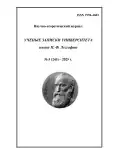СРАВНИТЕЛЬНАЯ ХАРАКТЕРИСТИКА ПОКАЗАТЕЛЕЙ БЕГА ВЫСОКОЙ ИНТЕНСИВНОСТИ ФУТБОЛИСТОВ РАЗЛИЧНЫХ ИГРОВЫХ АМПЛУА, ВЫСТУПАЮЩИХ В РОССИЙСКОЙ МОЛОДЕЖНОЙ ФУТБОЛЬНОЙ ЛИГЕ
- Авторы: Голубев Д.В.1,2, Щенникова М.Ю.3, Асена А.Р.4
-
Учреждения:
- Акционерное общество футбольный клуб Зенит
- Национальный государственный университет физической культуры, спорта и здоровья им. П.Ф. Лесгафта
- Национальный государственный Университет физической культуры, спорта и здоровья им. П.Ф. Лесгафта, Санкт-Петербург
- Выпуск: № 5 (2025)
- Страницы: 71-79
- Раздел: Теория и методика спорта
- URL: https://journals.rcsi.science/1994-4683/article/view/299745
- DOI: https://doi.org/10.5930/1994-4683-2025-71-79
- ID: 299745
Цитировать
Полный текст
Аннотация
Методы и организация исследования. В исследовании участвовали футболисты молодежной команды «Зенит», входящей в структуру департамента развития молодежного футбола ФК «Зенит», Санкт-Петербург. Применяли GPS технологию Gpexe системы Pro2 (Италия). Регистрировали следующие параметры: максимальная скорость (км/ч), высокоинтенсивные ускорения (>2,5 м/с2), кол-во раз; высокоинтенсивные торможения (>2,5 м/с2); зона скорости 19,8–25,1 км/ч, количество метров; зона скорости ≥25,2 км/ч, количество метров.
Результаты исследования и выводы. Установлено, что футболисты, игравшие в сезоне 2023-24, по сравнению с футболистами, игравшими в сезоне 2022-23, имеют более низкие значения в беге высокой интенсивности по GPS-показателям. Тренерам, работающим с футболистами на этапе подготовки групп спортивного совершенствования (возраст игроков 16–18 лет), при планировании учебно-тренировочных занятий технической, кондиционной, тактической и комбинированной направленности рекомендуется учитывать и использовать предложенные соревновательные ориентиры.
Об авторах
Денис Вячеславович Голубев
Акционерное общество футбольный клуб Зенит; Национальный государственный университет физической культуры, спорта и здоровья им. П.Ф. Лесгафта
Email: dengolubev@inbox.ru
департамент развития молодежного футбола
Марина Юрьевна Щенникова
Национальный государственный Университет физической культуры, спорта и здоровья им. П.Ф. Лесгафта, Санкт-Петербург
Email: mshchennikova@mail.ru
ректорат, доцент, доктор педагогических наук
Ангел Родригес Асена
Список литературы
- Vigh-Larsen J. F., Dalgas U., Andersen T. B. Position-specific acceleration and deceleration profiles in elite youth and senior soccer players // The Journal of Strength & Conditioning Research. 2018. Vol. 32, № 4. Р. 1114–1122.
- Akenhead R., Nassis G. P. Training load and player monitoring in high-level football: current practice and perceptions // International journal of sports physiology and performance. 2016. Vol. 11, №. 5. P. 587–593.
- Modric T., Versic S., Sekulic D. Playing position specifics of associations between running performance during the training and match in male soccer players // Acta Gymnica. 2020. Vol. 50, № 2. Р. 51–60.
- Load measures in training/match monitoring in soccer: A systematic review / Miguel M., Oliveira R., Loureiro N. [et al.] // International journal of environmental research and public health. 2021. Vol. 18, № 5. Р. 2721–2725.
- High- intensity running in English FA Premier League soccer matches / Bradley P. S., Sheldon W., Wooster B., Olsen P., Boanas P., Krustrup P. // J Sports Sci. 2009. Vol. 27, № 2. P. 159–168.
- Repeated-sprint sequences during youth soccer matches / Buchheit M. V., Mendez-Villanueva A., Simpson B. M., Bourdon P. C. // International journal of sports medicine. 2010. Vol. 31, № 10. Р. 709–716.
- Understanding deceleration in sport / Hewit J., Cronin J., Button C., Hume P. // Strength and Conditioning Journal. 2011. Vol. 33, № 1. P. 47–52.
- Diminutions of acceleration and deceleration output during professional football match play / Akenhead R., Hayes P. R., Thompson K. G., French D. // J Sci Med Sport. 2013. Vol. 16, № 6. P. 556–561.
- Change of direction frequency off the ball: New perspectives in elite youth soccer / Morgan O. J., Drust B., Ade J. D., Robinson M. A. // Science and Medicine in Football. 2022. Vol. 6, № 4. P. 473–482.
- A new approach to quantify angles and time of changes-of-direction during soccer matches / Kai T., Hirai S., Anbe Y., Takai Y. // Plos one, 2021. Vol. 16, № 5. P 127–135.
- Maddison R., Ni Mhurchu C. Global positioning system: A new opportunity in physical activity measurement // Int. J. Behav. Nutr. Phys. Activity. 2009. Vol. 6. Р. 1–8.
- Varley M. C., Fairweather I. H., Aughey R. J. Validity and reliability of GPS for measuring instantaneous velocity during acceleration, deceleration, and constant motion // Journal of sports sciences. 2012. Vol. 30, № 2. P. 121–127.
- Monitoring accelerations with GPS in football: time to slow down? / Buchheit M., Al Haddad H., Simpson B. M., Palazzi D., Bourdon P. C., Di Salvo V., Mendez-Villanueva A. // International journal of sports physiology and performance. 2014. Vol. 9, № 3. P. 442–445.
- Progressive statistics for studies in sports medicine and exercise science / Hopkins W. G., Marshall S. W., Batterham A. M., Hanin J. // Medicine Science in Sports Exercise. 2009. Vol. 41, № 1. P. 3.
Дополнительные файлы









